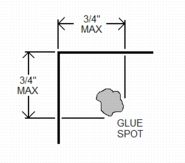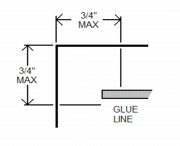On April 15, 2009, the Postal Service™ published a Federal Register final rule (74 FR 17399–17403) to reflect the construction and sealing of letter-sized booklets mailed at automation, presorted machinable or carrier route letter prices, effective September 8, 2009.
Also effective September 8, 2009, we are including the following additions to Mailing Standards of the United States Postal Service, Domestic Mail Manual (DMM®) 201.3.15.4 to:
n Clarify tab placement on small letter-size booklets.
n Clarify construction of mailpieces with glued flaps.
n Add one booklet sealing option.
The Federal Register final rule may be read on Postal Explorer® at http://pe.usps.com; click Federal Register Notices in the left frame.
This article includes the complete DMM changes in the Federal Register notice, as well as the new additional standards and clarifications.
Mailing Standards of the United States Postal Service, Domestic Mail Manual (DMM)
* * * * *
200 Commercial Letters and Cards
201 Physical Standards
1.0 Physical Standards for Machinable Letters and Cards
1.1 Physical Standards for Machinable Letters
* * * * *
1.1.3 All Machinable Letters
[Revise text of 1.1.3 as follows:]
All machinable letters must meet the standards for automation-compatible letters in 201.3.0.
* * * * *
3.0 Physical Standards for Machinable and Automation Letters and Cards
3.1 Basic Standards Automation Letters and Cards
[Revise text of 3.1 as follows:]
Letters and cards claimed at any machinable, automation, or Standard Mail carrier route price must meet the standards in 3.0. Unless prepared as a folded self-mailer, booklet, or postcard under 3.14 through 3.16, each machinable or automation letter must be a sealed envelope (the preferred method) or, if unenveloped, must be sealed or glued completely along all four sides.
[Delete current 3.4 through 3.6 in their entirety.]
[Renumber current 3.2 through 3.3 as new 3.3 through 3.4.]
[Add new 3.2 as follows:]
3.2 Paper Weight
Mailpieces should be constructed from high tear strength paper stock. All references in 3.0 to paper basis weight are for book-grade paper unless otherwise stated. The conversion table in Exhibit 3.2 provides a paper basis weight cross-reference.
Exhibit 3.2 Paper Basis Weight Conversion Table
[Revise heading and introductory text of renumbered 3.3 as follows:]
3.3 Dimensions and Shape
Each machinable or automation letter-sized piece must be rectangular (see 1.1.1) and must meet the following standards (see 3.15 for booklets):
* * * * *
[Add new 3.5 as follows:]
3.5 Maximum Weight, Machinable and Automation Letters and Cards
The following maximum weight limits apply:
a. Booklets and folded self-mailers — 3 ounces.
b. Machinable enveloped letters and cards —
3.3 ounces.
c. Automation enveloped letters and cards —
3.5 ounces (see 3.6 for pieces over 3 ounces.)
[Renumber current 3.14.4 as new 3.6 and revise heading and text as follows:]
3.6 Heavy Letter Mail (over 3 ounces)
Heavy letter mail (letter-size pieces over 3 ounces) must be prepared in a sealed envelope, may not contain stiff enclosures, and must have an 11-digit delivery point POSTNET or an Intelligent Mail barcode with a routing code in the address block (see 202.5.0).
* * * * *
[Revise heading and text of 3.11 as follows:]
3.11 Tabs, Tape, and Glue
Tabs on booklets must be at least 1-1/2 inches in width. The tab placement standards in 3.15 are subject to 1/4-inch variance in either direction. Tabs may be made of opaque paper, translucent paper, vinyl, or plastic, and must not contain perforations. Cellophane tape may also be used as a closure. The following standards also apply:
a. Translucent paper tabs should be made of paper with a minimum of 40-pound basis weight.
b. Opaque paper tabs should be made of a minimum of 60-pound basis weight paper with a tear strength of at least 56 grams of force in the machine direction (MD) and 60 grams of force in the cross direction (CD).
c. Tabs in the barcode clear zone must have a paper face meeting the standards for background reflectance and, if the barcode is not preprinted by the mailer, the standards for acceptance of water-based ink.
d. Vinyl tabs and cellophane tape closures are not acceptable within the barcode clear zone.
e. Tabs must be tight against the edge of the mailpiece. A maximum 1/16-inch overhang is recommended.
f. Glue spots may be used in lieu of tabs and must be placed within 3/4 inch of the open edges (see Exhibit 201.3.11.f).
Exhibit 201.3.11.f Glue Spot Placement

g. Continuous glue lines may be used as cover-to-cover seals and must be placed along the entire length of the open edge and end no more than 3/4 inch from the open ends (see Exhibit 201.3.11.g).
Exhibit 201.3.11.g Glue Line Placement

* * * * *
[Revise the title of 3.14 and restructure as follows:]
3.14 Folded Self-Mailers
[Renumber current 3.14.1 as new 3.14 and add new 3.14.1 as follows:]
3.14.1 General
The standards in 3.14.2 for folded self-mailers are basic requirements.
[Renumber current 3.15 as new 3.17. Renumber current 3.14.2 as new 3.15 and revise as follows:]
3.15 Booklets
3.15.1 Definition
Booklets must have a bound edge. Sheets that are fastened with at least two staples in the manufacturing fold (saddle stitched), perfect bound, pressed-glued, or joined together by another binding method that produces an end where pages are attached together are considered booklets. Booklets are open on three sides before sealing, similar in design to a book. In general, booklets must be uniformly thick. Large bound booklets that are folded for mailing qualify for automation and machinable prices if the final mailpiece remains nearly uniform in thickness.
3.15.2 Paper
Booklet covers generally must be made with a minimum paper basis weight of 60 pounds or equivalent. Minimum basis weights are higher for some designs (see 3.15.4).
3.15.3 Physical Standards for Booklets
Booklets must be:
a. Height: not more than 6 inches or less than 3.5 inches high.
b. Length: not more than 10.5 inches or less than 5 inches long. See Exhibit 3.15.4 for some booklet designs with shorter maximum lengths.
c. Thickness: not more than 0.25 inch or less than 0.009 inch thick.
d. Weight: not more than 3 ounces.
e. Aspect ratio: within 1.3 to 2.5 (see 201.3.1).
3.15.4 Booklet Design and Sealing
[Revise text of 3.15.4 as follows:]
The position of the final fold and intermediate fold (or spine) for letter-sized booklets varies according to the specific design of the mailpiece. Open edges can be sealed with tabs, glue lines, or glue spots. Tabs used as seals on small booklets (those between 3 1/2 and 5 inches high) may be placed closer to the top and bottom edges than shown in exhibit 3.15.4, and may overlap in some cases. See exhibit 3.15.4 for design and sealing standards.
Exhibit 3.15.4 Booklet Design
* * * * *
[Renumber current 3.14.3 as new 3.16.]
— Mailing Standards, Pricing, 7-30-09
